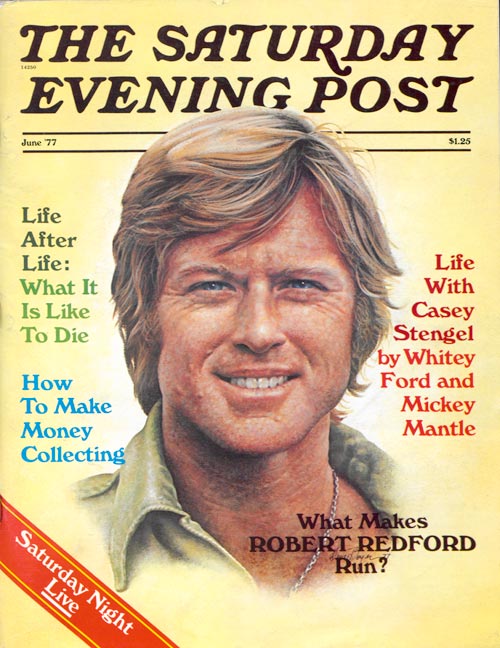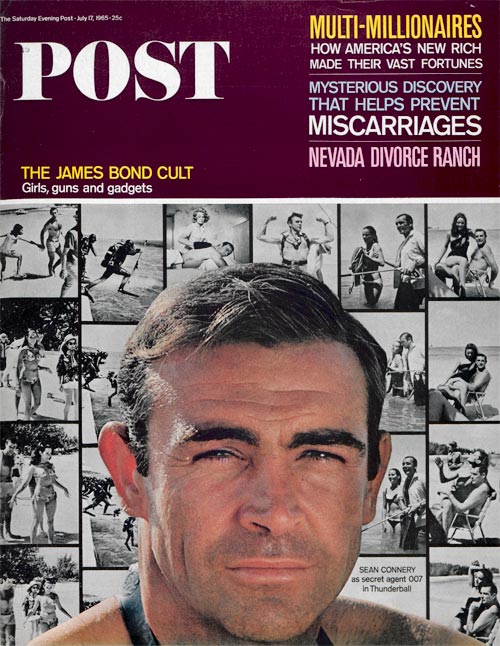Sure, 1960’s and 70’s covers depicted the Vietnam War and politics. But happily, on occasion, a celebrity showed up. Last week, it was leading ladies. This week, celebrity covers showing some of the hottest male actors of the 1960s and 70s. We’ll call them our “leading men.”
Paul Newman by Gene Boyer, October 1977

October 1977
Illustration by Gene Boyer
Was there ever a cooler celebrity? His interests were as varied as auto-racing and large-scale philanthropy. And oh, yes, he was a darn fine actor. “Newman’s attraction as an actor has by now taken on some of the characteristics of a mythologically immortalized shrine where everyone wants to stand for a moment just to feel the magic,” wrote Erin James in the cover story. We in Indy know the mythological magic of a Newman spotting at the race track, sunglasses not quite eclipsing his handsome visage. This beautiful cover in 1977 was by artist Gene Boyer, who also did a Post cover of another famous actor and Newman pal earlier in the year (below).
Robert Redford by Gene Boyer, June 1977

June 1977
Illustration by Gene Boyer
The same artist captured not only the tousled blonde hair (sigh) and blue eyes in this 1977 cover, but the charm and intelligence as well. The baseball player in The Natural, the bearded mountain man in Jeremiah Johnson, the ambitious reporter in All the President’s Men—all worthy of another look. But combining him with Newman in Butch Cassidy and the Sundance Kid (1969) and The Sting (1973) was casting serendipity to be savored over and over again. Redford, of course, also gained renown as a director.
Marlon Brando by Eric Carpenter, photographer, June 16, 1962

June 16, 1962
Photo: Eric Carpenter
Billy Wilder, the noted writer-director, was having dinner with President Kennedy. “Wilder,” our article states, “prides himself on his knowledge of world affairs” and was prepared to intelligently discuss Laos or Berlin. “Instead the President devoted himself to the burning question: ‘When in the world are they going to finish Mutiny on the Bounty?'” The Brando cover had an accompanying story of how he was acting like a Hollywood brat. Gee, we’re glad that never happens anymore – well, except for Lohan. And Gibson. And…well, we digress. The director was quoted as saying the picture “should have been called The Mutiny of Marlon Brando.” Okay, in Brando’s defense, the film’s producer said “…with a modern actor like him, he’s got to feel the part and you must allow him to make his contributions to the script and the directing. Otherwise he can’t work.” We’re not advising you try to tell your boss that you’re just not “feeling” it, but that’s up to you.
Sean Connery by Pierluigi & Loomis Dean, photographers, July 17, 1965

July 17, 1965
Photo: Pierluigi & Loomis Dean
The Bond phenomena did not escape The Saturday Evening Post. In July 1965, Sean Connery stands out against a background of Bond stills depicting “Girls, Guns and Gadgets.” There were photographers capturing Connery, all right: French, German, Swedes, English, Australian, and Canadian. “It was the biggest story I’ve ever been on,” wrote William K. Zinsser, “and it wasn’t any mere Dominican uprising or Cuba blockade. It was even bigger than that—the new James Bond movie was being filmed in the Bahamas!” The movie was Thunderball.
Richard Burton by Paul Ronald, photographer, December 3, 1966

December 3, 1966
Photo: Paul Ronald
“Richard Burton as the triumphant lover” read the caption. The lover in question was the lead in director Franco Zeffirelli’s The Taming of the Shrew. The Post cover was actually of Burton’s stunning wife Elizabeth Taylor as the shrew to be tamed (as we saw last week), and the cover cleverly folded out to show the male lead, full of all the bravado and magnetism of Shakespeare’s Petruchio…or of Richard Burton, come to that.
Cary Grant by Peter C. Borsari, photographer, March 1978

March 1978
Photo: Peter C. Borsari
“He’s the only actor,” wrote a Hollywood columnist, “whom other actors will turn around to see when he enters a room.” Even at age seventy-four, at the time of this 1978 cover, he was dashing and charismatic. The Post article attributed his youthfulness to “a regimen of exercise, moderation in food and drink and a penchant for enthusiasm (‘Marvelous!’ is his favorite response)”. The fact that he had a pretty thirty-two-year-old “companion” probably assisted as well. To quote actress Suzy Parker: “Who else goes to drive-in movies in a Rolls and totes champagne for refreshment?” How he managed to be charming, distinguished and funny was a conundrum we never solved, but always enjoyed. “The drama in a Cary Grant movie,” our article states, quoting critic Richard Schickel, “always lies in seeing if the star can be made to lose his wry, elegant and habitual aplomb. The joke likes in the fact that no matter what assaults and indignities the writer and director visit upon his apparently ageless person, he never does.”
Become a Saturday Evening Post member and enjoy unlimited access. Subscribe now




Comments
These men were stars, but not the top leading men of the Sixties and Seventies. With the exception of Redford these men were already past their prime.
It was wonderful seeing these photographs and remembering the movies each man had made. I must say I was a big fan of the movie “The Natural.” I saw it, then I took my sons to see it, and they were (almost) teenagers at the time. I wanted them to see how Redford played because he knew he had a natural talent for the sport and couldn’t be bought. The music was wonderful too. I have the movie and the soundtrack. Thanks for stirring some good memories.